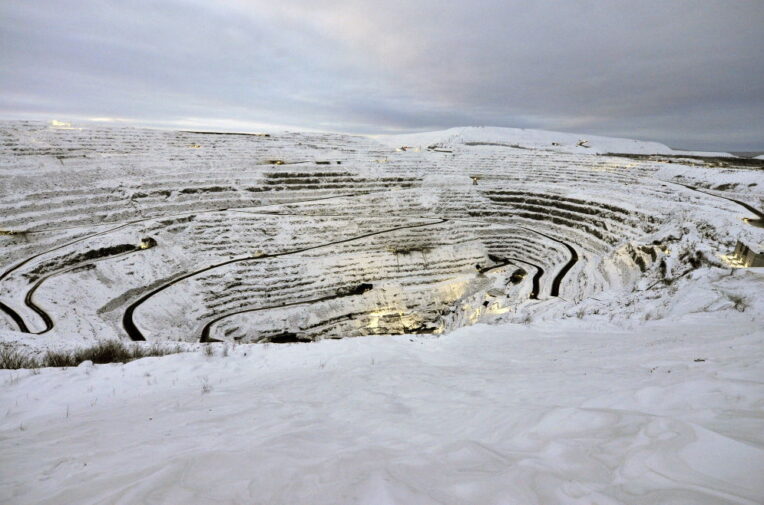
Hazardous substances may be discharged throughout the Arctic as the ice-bound earth warms, according to research. According to research published on March 28 in Nature Communications, by the end of the century, the thaw could undermine the structural integrity of more than 2,000 industrial sites, including mines and pipelines, and put more than 5,000 already-contaminated areas in danger. According to a report by Science News, these numbers are based on the first comprehensive examination of the locations where the thawing of the Arctic permafrost could release industrial toxins. However, according to Moritz Langer, a permafrost researcher at the Alfred Wegener Institute in Potsdam, Germany, there may be even more polluted places that we are not aware of. He told Science News, “We only see the tip of the iceberg.” Toxic compounds emitted from these sites could endanger the health of fish and other species living in Arctic rivers, as well as those who rely on them.
The thickness of permafrost can range from one metre (approximately three feet) to more than 1,000 metres (3,281 ft). In the Northern Hemisphere, permafrost spans roughly 22.8 million square kilometres (about 8.8 million square miles). Permafrost is not always the same as frozen ground. A layer of soil that freezes for more than 15 days a year is referred to as “seasonally frozen ground.” A layer of soil that freezes between one and fifteen days each year is referred to as “intermittently frozen ground.” Permafrost has been frozen for at least two years.
The Arctic is warming almost four times as quickly as the rest of the planet as a result of climate change
The Arctic is warming almost four times as quickly as the rest of the planet as a result of climate change, and up to 65 per cent of the region’s permafrost may melt by 2100. This could raise some issues, according to climate scientist Kimberley Miner of NASA’s Jet Propulsion Laboratory in Pasadena, California, who was not involved in the study. In 2021, Miner and her coworkers warned that the warming permafrost in the Arctic might release viruses, germs, and radioactive waste from nuclear testing operations into the ecosystem.
To estimate where warming would spread industrial pollutants, Langer and his colleagues originally looked at the extent of Arctic permafrost and the location of industrial infrastructure. In regions where permafrost is likely to exist, they found over 4,500 sites, including oil fields, mines, and abandoned military outposts. The researchers next examined contamination data from Canada and Alaska, two territories with readily available statistics, and found that as of January 2021, there were roughly 3,600 polluted places in each of these two regions. These include areas where toxins were mistakenly released and landfills.
The researchers found that about half of the pollution found in Alaska is caused by diesel, petrol and related petrochemicals. There were also traces of mercury, lead, and arsenic, all of which are harmful to humans, fish, and other creatures. The kind of contaminant, however, was frequently not stated. According to Langer, “that’s a big problem,” in part because it makes figuring out the risks associated with a particular leak or spill much more challenging. They discovered that at about 1,000 of the known industrial sites and 2,200 to 4,800 of the known and anticipated polluted locations, there is already a risk of permafrost erosion. These estimates increase to over 2,100 industrial sites and 5,600 to 10,000 contaminated areas in a low-emissions scenario with the warming of up to 2 degrees Celsius over preindustrial levels by the end of the century. Nearly all known and predicted sites would almost surely be impacted by a temperature increase of about 4.3 degrees Celsius.
There will be “a pulse of carbon released” from permafrost to the atmosphere within the next hundred years
According to scientists, thawing permafrost can have a significant influence on the environment, said a report by the Indian Express. The release of greenhouse gases into the environment is one of its most harmful repercussions. According to a NASA report from 2022, “Arctic permafrost alone contains an estimated 1,700 billion metric tonnes of carbon, including methane and carbon dioxide.” That is nearly 51 times the amount of carbon emitted by the planet as a result of fossil fuel combustion in 2019.” Furthermore, “Plant matter frozen in permafrost does not decay; however, when permafrost thaws, microbes within the dead plant material begin to break down the matter, releasing carbon into the atmosphere,” it noted.
There will be “a pulse of carbon released” from permafrost to the atmosphere within the next hundred years, if not sooner, according to the report’s analysis of current models. The amount of carbon that will be released from permafrost in the upcoming years is uncertain. A Columbia University study from 2022 predicted that melting permafrost would cause hundreds of bacteria and viruses to emerge from dormancy. Several of them “could be new viruses or ancient ones for which humans lack immunity and cures, or diseases that society has eliminated, such as smallpox or Bubonic plague,” according to the research.
